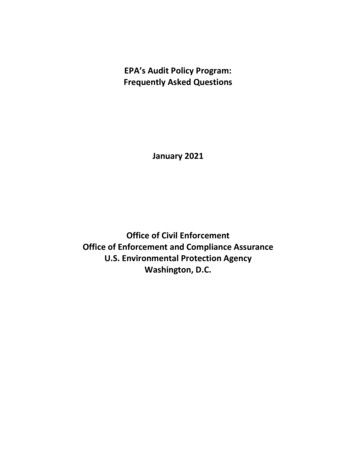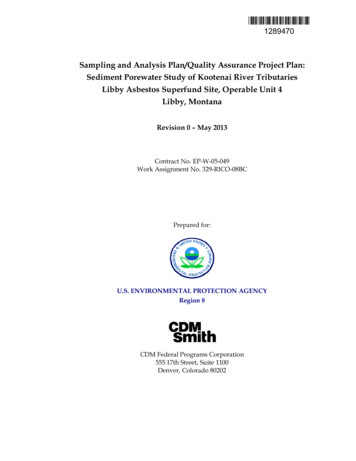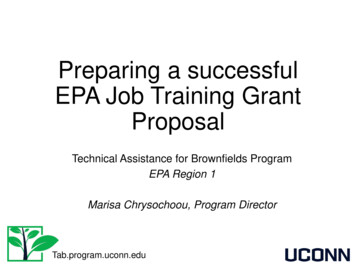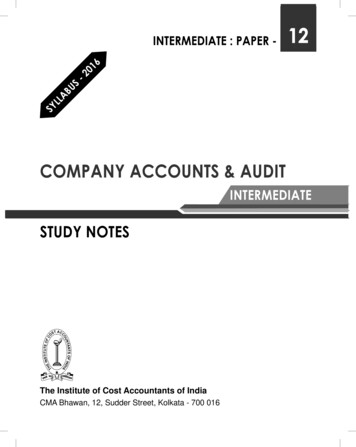
Transcription
EPA’s Audit Policy Program:Frequently Asked QuestionsJanuary 2021Office of Civil EnforcementOffice of Enforcement and Compliance AssuranceU.S. Environmental Protection AgencyWashington, D.C.
Explanatory NoteThis document was prepared by the U.S. Environmental Protection Agency’s (EPA or theAgency) Office of Civil Enforcement (OCE) in conjunction with the national Audit PolicyCoordination Team (ACT). The ACT is chaired by OCE and is charged with making fair andnationally consistent recommendations concerning the applicability of the policy on Incentivesfor Self-Policing: Discovery, Disclosure, Correction and Prevention of Violations, 65 Fed. Reg.19618 (Apr. 11, 2000) (referred to in this document as the Audit Policy), the Small BusinessCompliance Policy, 65 Fed. Reg. 19630 (Apr. 11, 2000), and the Interim Approach to Applyingthe Audit Policy to New Owners, 73 Fed. Reg. 44991 (Aug. 1, 2008) (referred to in thisdocument as the New Owner Audit Policy). In addition to these three self-disclosed violationspolicies, EPA’s Audit Policy Program includes the eDisclosure system which is an online systemfor receiving and automatically processing violation disclosures under the Audit Policy andSmall Business Compliance Policy.This document uses a Question and Answer format to highlight key policy matters that areoften asked about in the Audit Program and respond to requests for clarification by theregulated community. It supersedes the 1997 “Audit Policy Interpretive Guidance”, 2007“Frequently Asked Questions”, and 2015 “eDisclosure FAQs” in part because some of thequestions and answers in those three documents are no longer relevant, particularly those thatwere based on an implementation approach that involved an exchange of hard copycommunications between the entity self-disclosing violations and EPA. Since EPA launched theeDisclosure system, all Audit Policy and Small Business Compliance Policy disclosures areautomatically and electronically processed via that system. This document incorporates anyissues discussed in the 1997 “Audit Policy Interpretive Guidance”, 2007 “Frequently AskedQuestions”, and 2015 “eDisclosure FAQs” that remain relevant, and presents those issues in auser-friendly manner, including any updates. The questions and answers available on theeDisclosure Central Data Exchange (CDX) online portal remain in place as they are related toportal logistics and mechanics.EPA welcomes comments on this document, and on additional interpretive issues that may beappropriate for resolution in future FAQs or in Agency guidance.This document provides information about how the Agency exercises its enforcementdiscretion. It is not final agency action and it does not create any rights, duties, obligations, ordefenses, implied or otherwise, in any third parties.This document can be found on the Internet at https://www.epa.gov/compliance/epas-auditpolicy. Revisions or additions to this document also will be made publicly available on theInternet.i
EPA’s Audit Policy Program: Frequently Asked Questions (2021)Table of ContentsExplanatory Note . iTable of Contents .iiGeneral Audit Policy Program Qs and As. 1Relationship of These Frequently Asked Questions (FAQs) to Prior EPA Guidance and FAQs. 1Systematic Discovery. 1Voluntary Discovery . 2Prompt Disclosure . 4Independent Discovery and Disclosure. 5Correction and Remediation . 6No Repeat Violations. 6Other Violations Excluded. 9Enforcement Policy and Practice . 9Miscellaneous Issues. 11New Owner Audit Policy Qs and As . 11Benefits of the New Owner Audit Policy. 11Eligibility Requirements . 12Relationship to eDisclosure System . 14Enforcement Policy and Practice . 14eDisclosure Qs and As. 16Submitting Confidential Business Information (CBI). 16Prompt Disclosure via eDisclosure. 17No Repeat Violations. 17Expeditious Correction Condition . 18Online Portal Mechanics and Implementation . 19Enforcement Practice and Policy . 21Small Business Compliance Policy Q and A. 22ii
General Audit Policy Program Qs and AsThis section generally describes what regulated entities should or should not do to satisfy a conditionin one or more of the policies in the Audit Program. Any language suggesting what an entity “must” or“should” do refers to an entity wanting to obtain penalty mitigation under one of the self-disclosedviolations policies. (Note, EPA uses the terms “regulated entity” and “entity” interchangeablythroughout these FAQs.)Relationship of These Frequently Asked Questions (FAQs) to Prior EPA Guidance and FAQs1. Should one still consult EPA’s 1997 “Audit Policy Interpretive Guidance”, 2007 “Audit Policy:Frequently Asked Questions”, and 2015 “eDisclosure FAQs” on Audit Policy Program issues?No. This document supersedes the 1997 “Audit Policy Interpretive Guidance”, 2007 “Frequently AskedQuestions”, and 2015 “eDisclosure FAQs” in part because some of the Qs and As in those documentsare no longer relevant, particularly those that were based on an implementation approach thatinvolved an exchange of hard copy communications between the entity self-disclosing violations andEPA, prior to the adoption of the eDisclosure system. This document includes those issues from the1997 “Audit Policy Interpretive Guidance”, 2007 “Frequently Asked Questions”, and 2015 “eDisclosureFAQs” that remain relevant.Systematic Discovery2. Are regulated entities required to give EPA advance notice of their intent to undertake an audit?No, regulated entities are not required to provide EPA with advance notice of their intent to undertakean audit.3. Are regulated entities required to complete their audit within a specific time frame and, if so, whattimeframe?No, for existing owners, there is no specific time frame within which regulated entities must completetheir audit as a condition of obtaining penalty mitigation. Where new owners and EPA enter into anaudit agreement, however, they will need to agree to a timeframe in which to complete an audit. Seee.g., New Owner Audit Policy, 73 Fed. Reg. at 44996-97. See Q & A #9 for information about promptdisclosures during extended audits, including compliance with the 21-day prompt disclosure condition.Page 1
Voluntary Discovery4. A regulated entity discovered noncompliance that is required to be reported to the regulatoryagency pursuant to the applicable statute, regulations, and/or permit. Does this mean the regulatedentity does not meet the voluntary discovery condition?No, the voluntary requirement applies to discovery only, not reporting. That is, any violation voluntarilydiscovered may be still eligible for penalty mitigation, regardless of whether the regulated entity wasrequired to report the violation after finding it.5. Under what circumstances, if any, can discovery of Clean Air Act (CAA) Title V violations be“voluntary” under the various self-disclosed violations policies?Generally, CAA violations discovered during activities supporting Title V certification requirements arenot considered to be “voluntarily discovered.” The regulations implementing Title V require acomprehensive inquiry as to a permit applicant’s compliance with “all applicable requirements,” 40C.F.R. § 70.5, and a periodic (at least annually) compliance certification with the terms and conditionsof a Title V permit for permit holders, 40 C.F.R. § 70.6(c). Thus, discovery of any violations as part ofthese processes is not voluntary and, therefore, generally is not eligible for penalty mitigation underthese policies. See New Owner Audit Policy, 73 Fed. Reg. at 44993. There are, however, the followingpossible exceptions where EPA may allow for penalty mitigation in the Title V context on a case-bycase-basis:For existing owners:(1)violations that the regulated entity discovers and discloses well in advance of, and thatare not prompted by, the Title V application process;(2)violations that the regulated entity discovers and discloses after it has submitted acomplete Title V permit application, but prior to any compliance certification requirement in anissued Title V permit that would require certification as to the violated underlying requirement,provided such violations were new or unforeseeable at the time of the permit application (forexample, where a source’s Title V permit is missing an applicable requirement because theregulating agency – through no omission of required information or fault on the part of theregulated entity – issued the permit without including that standard, thus allowing the sourceto voluntarily discover violations of such standard because the annual certification regulationsat 40 C.F.R. § 70.6(c)(5) only require sources to determine their compliance with “the terms andconditions contained in the permit”);For new owners:(3)violations a new owner discloses either (i) in writing to EPA before the due date of anyrequired Title V compliance certification, monitoring, sampling, or auditing or (ii) pursuant to anauditing and disclosure schedule established in an audit agreement that EPA and the newPage 2
owner entered into before the due date of any required Title V compliance certification,monitoring, sampling, or auditing. New Owner Audit Policy, 73 Fed. Reg. at 44993, 45000.6. Under what circumstances, if any, can disclosure of Clean Water Act National Pollution DischargeElimination System (NPDES) permit violations meet the voluntary discovery condition under thevarious self-disclosed violations policies?Because NPDES regulations and permits require facilities discharging pollutants to waters of the UnitedStates to periodically evaluate their compliance status with applicable effluent limitations and otherpermit requirements, 40 C.F.R § 122.44 and 40 C.F.R. § 122.48, discovery of NPDES permit violationsthrough such prescribed monitoring is not voluntary and, therefore, such violations generally are noteligible for penalty mitigation under the self-disclosed violations policies. See Audit Policy, 65 Fed. Reg.at 19621, 19625; New Owner Audit Policy, 73 Fed. Reg. at 45000. The EPA has identified one exceptionto this rule, which is under the New Owner Audit Policy where new owners:“correct violations found, and upgrade deficient equipment and practices, as soon as possible and either disclose violations or enter into an audit agreement with an auditing and disclosureschedule, before the first instance when the monitoring, sampling or auditing is required Forexample, an entity [a new owner] could perform its Annual Comprehensive Site ComplianceEvaluation required by the NPDES General Industrial Stormwater Permits and StormwaterPollution Prevention Plans (SWPPP) prior to its due date, and discover and disclose violationsfor Audit Policy consideration.”New Owner Audit Policy, 73 Fed. Reg. at 45000.7. Can an entity be deemed to have voluntarily discovered its violations where the violations arediscovered during the conduct of a compliance audit that is required as part of a binding settlement?Generally, no. The Audit Policy defines voluntariness to exclude situations where the violations are“discovered through a compliance audit required to be performed by the terms of a consent order orsettlement agreement." Audit Policy, 65 Fed. Reg. at 19621, 19625. The settlement agreement itselfshould address how such violations will be resolved, via terms of the binding settlement (e.g., whetherand how penalty mitigation may be available for violations discovered as part of a compliance auditrequired by the settlement). Thus, resolution of any violations discovered through a compliance auditrequired by a settlement must be resolved outside the eDisclosure system, through the settlementcase team.However, there is an exception to this general rule, when discovery of a violation that results fromactions pursuant to a settlement may be able to meet the “voluntary discovery” condition. If theviolations are discovered pursuant to an audit which is “a component of agreement terms toimplement a comprehensive environmental management system” they could meet the voluntarydiscovery condition. Audit Policy, 65 Fed. Reg. at 19621, 19625. As noted in the Audit Policy:Page 3
“In general, EPA supports the implementation of EMSs that promote compliance,prevent pollution and improve overall environmental performance. Precluding theavailability of the Audit Policy for discoveries made through a comprehensive EMS thathas been implemented pursuant to a settlement agreement might discourage entitiesfrom agreeing to implement such a system.”Id. at 19621.Prompt Disclosure8. Are regulated entities required to affirmatively admit that they have violated the law?No, regulated entities can disclose that they “may have” violated the law. See Audit Policy, 65 Fed. Reg.at 19626; Small Business Compliance Policy, 65 Fed. Reg. at 19633; New Owner Audit Policy, 73 Fed.Reg. at 45001.9. If an audit will take some time to complete (e.g., perhaps several months), when does theregulated entity have to disclose violations to meet the 21-day prompt disclosure condition?Although the Audit Policy itself does not establish a firm time limit for completing audits, regulatedentities meet the Audit Policy’s prompt disclosure condition only if they disclose potential violationswithin 21 days of when they obtain an “objectively reasonable factual basis” for concluding thatspecific violations may have occurred. Discovery may occur prior to completion of the audit or auditreport, or at their completion. If discovery occurs at different times for different violations, eachviolation would have to disclosed within 21 days of discovery to be timely. See also Q & A #34,explaining that there may also be some value in a late disclosure after 21 days as part of an effort todemonstrate “good faith” for later consideration if there is an EPA enforcement action.As EPA explained in the Audit Policy, a violation is discovered when “any officer, director, employee oragent of the facility has an objectively reasonable basis for believing that a violation has, or may have,occurred. The ‘objectively reasonable basis’ standard is measured against what a prudent person,having the same information as was available to the individual in question, would have believed. It isnot measured against what the individual in question thought was reasonable at the time the situationwas encountered.” Audit Policy, 65 Fed. Reg. at 19621EPA’s longstanding interpretation of when a specific violation may have occurred (triggering thebeginning of the 21-day period in which to disclose violations) may provide some flexibility. As EPAexplained as early as the 1997 Audit Policy Interpretive Guidance, absolute factual and legal certainty isnot necessary in order to trigger the beginning of the 21-day period in which to promptly discloseviolations. This is particularly true where there is a reasonable certainty as to the facts underlyingpotential violations. For example, where an entity discovers that specific violations occurred at onelocation or facility and has the same equipment and operations elsewhere, an inference can be drawnthat other violations may have occurred and the company should disclose these other possibleviolations to the Agency at the same time it discloses the initial violation. If, however, equipment andPage 4
operations elsewhere are not identical or where it is unknown whether they are substantially similar,discovery may not have occurred for other locations or facilities. In such circumstances the entity canaudit or otherwise take steps to voluntarily discover other potential violations and timely disclosethose in the eDisclosure system all at once or piecemeal. The timing for each such disclosure isdetermined by when sufficient information becomes available to conclude that specific violations mayhave occurred.Independent Discovery and Disclosure10. In a discussion, EPA suggested that an entity audit for violations or suggested expanding existingaudit efforts to additional facilities or locations. Does that disqualify the entity from the selfdisclosed violations policies?Not necessarily, but it depends on the facts. Unless the EPA is about to discover the discussedviolations, or is already investigating the additional facilities or locations, a mere suggestion from theEPA that an entity consider auditing will not necessarily disqualify the entity under the independentdiscovery and disclosure condition. If the regulated entity is unsure as to whether the EPA will considerany violations discovered via such audits to be independently discovered and disclosed, it can ask theEPA to clarify its position prior to conducting the audits.The Audit Policy requires that regulated entities discover and disclose violations independent ofdiscovery or likely discovery by a government or third-party plaintiff:“[t]hat is, the violation must be discovered and identified before EPA or another governmentagency likely would have identified the problem either through its own investigative work orfrom information received through a third party. This condition requires regulated entities totake the initiative to find violations on their own and disclose them promptly instead of waitingfor an indication of a pending enforcement action or third-party complaint.”65 Fed. Reg. at 19622.The EPA also stated in the Audit Policy that “where the entity does not know that EPA has commenceda civil investigation and proceeds in good faith to make a disclosure under the Audit Policy, EPA may, inits discretion, provide penalty mitigation under the Audit Policy.” Id. Moreover, EPA noted that:“EPA encourages multi-facility auditing and does not intend for the ‘independent discovery’condition to preclude availability of the Audit Policy when multiple facilities are involved. Thus,if a regulated entity owns or operates multiple facilities, the fact that one of its facilities is thesubject of an investigation, inspection, information request or third-party complaint does notautomatically preclude the Agency from granting Audit Policy credit for disclosures of violationsself-discovered at the other facilities, assuming all other Audit Policy conditions are met.”Id.Page 5
Similarly, the Small Business Compliance Policy states that the policy does not apply when the violationwas discovered through “an information request, inspections, field citations, or through aninvestigation unless the facility can demonstrate that it did not know that the agency had initiated theinvestigation and disclosed in good faith.” Small Business Compliance Policy 65 Fed. Reg. at 19633.Correction and Remediation11. What happens when it is not possible to correct a violation?The EPA recognizes that certain violations that involve parties, facilities, or wastes over which an entityno longer has control (e.g., the transport of hazardous waste without a RCRA manifest) may not in factbe physically correctable by the entity disclosing the violation. Similarly, an entity may not be able tocorrect a violation when the violation involved an activity that should have occurred within a certaintime window which has closed (e.g., within a certain number of days after start-up, or before sale orrental of property). In such circumstances, it is the EPA’s practice to not necessarily preclude aregulated entity from penalty mitigation under the self-disclosed violations policies based on thecorrection and remediation condition provided the regulated entity can demonstrate that it has takenappropriate measures to prevent recurrence of the disclosed violation(s) and has complied with anyother steps necessary to remedy the violation(s) (e.g., by performing the activity late, or by completingany removal or remedial actions required by law).No Repeat Violations12. Are violations identified in a non-penalty enforcement response such as a notice of violationconsidered to have “occurred previously” for purposes of the No Repeat Violations condition?It depends.a. The Audit Policy states that for purposes of the “No Repeat Violations” condition“a violation is:(a)Any violation of a Federal, State, or local environmental law identified in a judicial oradministrative order, consent agreement or order, complaint, or notice of violation, convictionor plea agreement; or(b)Any act or omission for which the regulated entity has previously received penaltymitigation from EPA or a State or local agency.”65 Fed. Reg. at 19626.The non-penalty enforcement responses included in the above definition (e.g., notice of violation)typically include, or occur after, an opportunity for the recipient to confer and contest any findings ofviolation. Thus, violations identified in the documents included in the above definition would beconsidered to have “occurred previously” for purposes of the No Repeat Violations condition if thePage 6
document has not been withdrawn or successfully challenged by the regulated entity. However,violations identified in documents where the recipient has not had an opportunity to confer are notconsidered to have “occurred previously” for the No Repeat Violations condition in the Audit Policy.Since the implementation of the eDisclosure system, the EPA also considers an electronic Notice ofDetermination (eNOD) to be a document like those in section (b) of the above definition for which anentity has received penalty mitigation. However, Acknowledgment Letters or Ineligibility Letters do notresult in penalty mitigation themselves, and otherwise do not identify a violation for purposes of theNo Repeat Violations condition.b. The Small Business Compliance Policy, however, has a slightly different provision for repeatviolations. The Small Business Compliance Policy does not appy if:“a. The facility has the following noncompliance history:i.It has previously received a warning letter, notice of violation, or field citation, orbeen subject to a citizen suit or any other enforcement action by a government agencyfor a violation of the same requirement within the past three years.ii.It has been granted penalty reduction under this Policy (or a similar State orTribal policy) for a violation of the same or a similar requirement within the past threeyears.iii.It has been subject to two or more enforcement actions for violations ofenvironmental requirements in the past five years, even if this is the first violation of thisparticular requirement.”65 Fed. Reg. at 19633 (emphasis added).13. When does the 3- or 5-year period begin for the purposes of the No Repeat Violations condition?The Audit Policy “No Repeat Violations” condition requires that “[t]he specific violation (or a closelyrelated violation) [disclosed] has not occurred previously within the past three years at the samefacility, and has not occurred within the past five years as part of a pattern at multiple facilities ownedor operated by the same entity.” Audit Policy, 65 Fed. Reg. at 19626. As noted above, the SmallBusiness Compliance Policy has a slightly different, but similar, provision for repeat violations. SmallBusiness Compliance Policy, 65 Fed. Reg. 19633. Question 12 answered what violations are counted asprior violations for purposes of the No Repeat Violations condition. This Question addresses when the3- or 5- year period commences for prior violations that count for purposes of the No Repeat Violationscondition.The 3- or 5-year period begins to run when the government has given the violator notice of theviolation per the applicable self-disclosed violations policy definition (see Q & A #12), not when thePage 7
violation actually took place. Thus, for example, an entity may have failed to provide a report onJanuary 1, 2020; received a notice of violation on June 1, 2020, and settled the violation in anadministrative order on December 1, 2020. The 3- or 5-year period for the “No Repeat Violations”condition runs from June 1, 2020, not December 1, 2020, forward.Note that the Audit Policy preamble at 65 Fed. Reg. at 19622-23 has a list of examples of “notice” ofprior violations that is inconsistent with the Audit Policy at 65 Fed. Reg. at 19626. To clarify, as statedin the Audit Policy, the EPA does not consider inspection reports and citizen suits to be documentswhich give notice for purposes of the “No Repeat Violations” conditions of the self-disclosed violationpolicies; however, these documents could impact the ability of the violator to meet the IndependentDiscovery and Disclosure condition.14. How, and how often, does EPA determine that there is a corporate pattern of violations forpurposes of determining whether an entity has satisfied the No Repeat Violations condition?Where the disclosed violation is the same as or closely related to violations that occurred “within thepast five years as part of a pattern at multiple facilities owned or operated by the same entity” thedisclosing entity has not satisfied the “No Repeat Violations” condition. Audit Policy, 65 Fed. Reg. at19623, 19626.Between 1995 and 2020, EPA found that an entity had not satisfied the no repeat violations conditiondue to a “corporate pattern” in less than one percent of all cases. As explained as early as the 2007Audit Policy FAQs, there is no specific number of prior violations that comprise a corporate pattern forpurposes of determining whether a disclosing entity has failed to satisfy this condition. The concept ofa corporate pattern of violations focuses on when the violations occurred, not on the number ofviolations disclosed at any one time. Thus, for example, an entity could conduct an audit that yields thediscovery and disclosure of dozens or hundreds of violations of the same or a closely related type atmultiple facilities. If those violations are discovered as part of one effort and disclosed together, EPAviews those violations as one disclosure for purposes of evaluating subsequent disclosures forcorporate pattern. Similarly, if an entity discovers violations at one facility and has reason to believethat the same or closely related violations exist at other facilities, the No Repeat Violations conditionwould not preclude an entity from disclosing the additional violations sequentially if the disclosures arepart of a single, comprehensive review of similar requirements across all of an entity’s facilities, aredisclosed promptly as defined under the applicable self-disclosed violations policy, and any disclosedviolations did not occur after the entity received noticed that it was in violation. See Q & A #12 formore on notice.Page 8
Other Violations Excluded15. How does EPA interpret the condition that excludes violations resulting in serious actual harm tothe environment or which may have presented an imminent and substantial endangerment to publichealth or the environment?Although many environmental violations involve the release of pollutants, such violations do notnecessarily result in serious actual harm or present an imminent and substantial endangerment. In thecontext of EPA’s self-disclosed violations program, EPA takes a case-by-case approach and has rarelyexcluded disclosures on this basis. Of the nearly 28,000 facilities disclosing to EPA between 1995 and2020, EPA denied Audit Policy Program penalty mitigation based on serious actual harm or animminent and substantial endangerment condition less than a dozen times. One of those instancesinvolved a release that required community evacuation of the surrounding area, and another involvedthe death of an employee.Enforcement Policy and Practice16. How does EPA decide whether
often asked about in the Audit Program and respond to requests for clarification by the regulated community. It supersedes the 1997 "Audit Policy Interpretive Guidance", 2007 "Frequently Asked Questions", and 2015 "eDisclosure FAQs" in part because some of the











